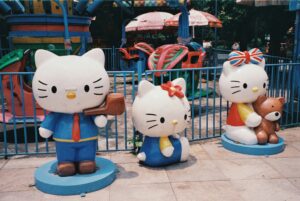In the dynamic world of video games, few characters have stood the test of time as well as Nintendo’s Mario. With his trademark red hat, mustache, and blue overalls, Mario has become more than just a pixelated character on a screen; he represents the heart and soul of the gaming industry. From his humble beginnings in the 1980s to his status today as a global icon, Mario has played a pivotal role in propelling Japan’s gaming industry to international triumph. This article delves into the history, evolution, and cultural significance of Nintendo’s most beloved character, exploring how Mario became the face of video gaming around the world.
1. Mario Leaps Into History: Nintendo’s Icon Emerges
Mario made his first appearance in 1981, not as a plumber but as "Jumpman" in the game Donkey Kong. Created by Shigeru Miyamoto, Mario was initially a carpenter facing off against a giant ape. The character’s relatable everyman persona quickly caught the attention of gamers. Nintendo soon recognized Mario’s potential, giving him a proper name and a backstory. By 1983, Mario had transitioned from side-scrolling platforms to starring in his own game, "Mario Bros.," alongside his brother Luigi. This game laid the foundation for the Mario universe, introducing players to the pipes and creatures that would become series staples. Mario’s ability to transcend his arcade origins and evolve with each gaming generation has solidified his place in gaming history.
2. From Arcade to Empire: The Evolution of Mario
The journey from arcade cabinets to a sprawling gaming empire is a testament to Mario’s enduring appeal. Following the success of "Mario Bros.," Nintendo launched "Super Mario Bros." on the NES in 1985, a game that would redefine the parameters of video gaming. With its scrolling levels, power-ups, and a narrative that went beyond simple rescue missions, "Super Mario Bros." established a template for countless games to follow. Over the years, Mario has ventured into various genres, from puzzle games like "Dr. Mario" to the role-playing world of "Paper Mario." Each iteration has expanded the Mario universe, introducing new characters, worlds, and gameplay mechanics, while maintaining the core elements that fans love.
3. The Mushroom Kingdom’s Global Conquest
Mario’s leap from the Japanese gaming scene to the global market is a story of cross-cultural appeal. The "Super Mario" series has sold over 330 million copies worldwide, making it one of the best-selling video game franchises. Its success lies not only in its gameplay but also in its universally appealing narrative: the hero’s quest to save the princess and the magical world of the Mushroom Kingdom. Mario games have been localized in numerous languages, allowing players from different cultures to embark on adventures with the Italian plumber. The franchise’s global reach has turned Mario into a cultural ambassador, bridging gaps between Japan and the rest of the world.
4. Shigeru Miyamoto: The Mind Behind Mario
The genius behind Mario is Shigeru Miyamoto, a visionary game designer whose creative philosophies have shaped the industry. Miyamoto’s approach to game design, focusing on fun and exploration over high scores, has made Mario games accessible and enjoyable for all ages. He draws inspiration from his own experiences, infusing Mario’s universe with a sense of wonder and adventure. Under Miyamoto’s direction, Nintendo has consistently pushed the boundaries of technology and storytelling, ensuring that Mario games remain at the forefront of innovation. His contributions to gaming have earned him numerous awards and recognitions, solidifying his status as a legend in the industry.
5. Power-Ups and Warp Pipes: Innovations in Gaming
The introduction of power-ups and warp pipes in Mario games has had a lasting impact on the gaming industry. These elements not only add depth to the gameplay but also offer players strategic choices, making each playthrough unique. Power-ups like the Super Mushroom, Fire Flower, and Starman have become iconic, granting Mario special abilities and influencing game design across various genres. Warp pipes, on the other hand, introduced the concept of secret levels and shortcuts, encouraging exploration and replayability. These innovations have become staples in video game design, demonstrating Mario’s influence on the creative direction of the industry.
6. Super Mario Bros.: Revolutionizing Video Games
"Super Mario Bros." is more than just a game; it’s a cultural phenomenon that revolutionized video gaming. Released in 1985, it introduced the world to side-scrolling platform games, setting a new standard for graphics, gameplay, and narrative. Its success saved the video game industry from the brink of collapse in the mid-80s, leading to the resurgence of home gaming consoles. The game’s design principles, emphasizing intuitive control and immersive worlds, have influenced countless developers. "Super Mario Bros." also pioneered the concept of a gaming franchise, leading to sequels, spin-offs, and merchandise that have become ingrained in popular culture.
7. The Mario Franchise: Expanding Beyond the Console
Mario’s influence extends far beyond the confines of video game consoles. The franchise has expanded into cartoons, movies, theme parks, and merchandise, becoming a ubiquitous presence in global pop culture. The Super Mario animated series and the 1993 live-action movie, despite mixed reviews, brought Mario into mainstream media. Nintendo’s partnerships with Universal Studios for Super Nintendo World theme parks have further cemented Mario’s status as a cultural icon. Moreover, Mario merchandise, from clothing to toys, allows fans to engage with the character in their everyday lives, demonstrating the franchise’s versatile appeal.
8. Mario Kart: Racing Into Gamers’ Hearts Worldwide
"Mario Kart" is a testament to the franchise’s ability to reinvent itself and remain relevant. Since its debut in 1992 with "Super Mario Kart," the series has become one of the most beloved racing games, known for its fun, competitive gameplay and iconic tracks. "Mario Kart" has not only introduced multiplayer gaming to a wider audience but also solidified the concept of crossover characters within the Mario universe. The series’ success highlights how Mario games can bring people together, transcending age and gaming skill levels, and showcasing Nintendo’s commitment to innovation and community building.
9. Mario’s Role in Japan’s Cultural Export Strategy
Mario has played a significant role in Japan’s strategy to export its culture globally. As a recognizable and beloved character, Mario serves as a bridge between Japan and the world, introducing audiences to Japanese creativity and storytelling. The government has recognized the character’s diplomatic potential, even appointing Mario as an ambassador for the 2020 Tokyo Olympic Games. Through Mario, Nintendo has contributed to the global fascination with Japanese pop culture, from anime to video games, bolstering the country’s soft power and cultural influence.
10. The Economics of Mario: Boosting Nintendo’s Fortunes
The financial impact of the Mario franchise on Nintendo cannot be overstated. Mario games have consistently driven hardware sales, encouraging consumers to purchase the latest Nintendo consoles. Titles like "Super Mario Odyssey" and "Mario Kart 8 Deluxe" have shattered sales records, contributing significantly to Nintendo’s revenue. The franchise’s ability to adapt and remain popular across generations has ensured a steady stream of income for the company, reinforcing Mario’s status as a key asset in Nintendo’s portfolio.
11. Mario in the Digital Age: Adapting to New Platforms
In the digital age, Mario has successfully transitioned to new platforms, from mobile gaming to virtual reality. Nintendo’s release of "Super Mario Run" for smartphones brought the character to a wider audience, demonstrating the company’s ability to adapt to changing gaming habits. Furthermore, the integration of Mario games into Nintendo Switch Online’s offerings has made classic titles accessible to new generations of gamers, preserving the franchise’s legacy. Nintendo’s foray into augmented reality with "Mario Kart Live: Home Circuit" showcases the innovative ways Mario continues to capture the imagination of players worldwide.
12. Future Adventures: What’s Next for Mario and Nintendo?
As Nintendo looks to the future, the possibilities for Mario are endless. With the gaming industry’s rapid evolution, Mario will undoubtedly continue to be at the forefront of innovation. Fans can anticipate new titles, technologies, and experiences that push the boundaries of what Mario games can be. Whether it’s exploring new genres, incorporating cutting-edge technology, or expanding the Mario universe in unexpected ways, Nintendo’s dedication to creativity and quality ensures that Mario’s adventures will continue to enchant and entertain for generations to come.
Nintendo’s Mario has evolved from a simple video game character into a global cultural icon, powering Japan’s gaming triumph and shaping the landscape of the industry. Through innovation, adaptation, and a relentless focus on fun, Mario has captured the hearts of millions around the world. As he leaps into the future, Mario remains a symbol of the universal appeal of video games, embodying the joy, creativity, and adventure that make gaming a beloved pastime. As long as there are new stories to tell and worlds to explore, Mario will continue to be a beacon of Nintendo’s enduring legacy and the magic of video games.








